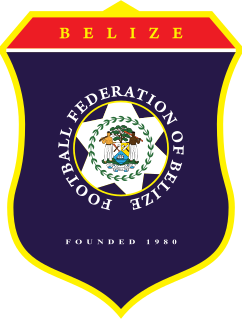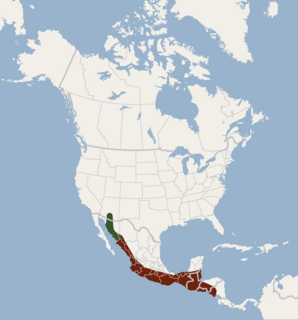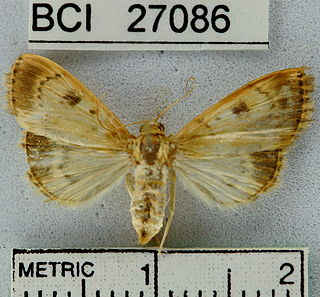Related Research Articles

Belize, formerly known as British Honduras, is a Caribbean country located on the northeastern coast of Central America. Belize is bordered on the northwest by Mexico, on the east by the Caribbean Sea, and on the south and west by Guatemala. It has an area of 22,970 square kilometres (8,867 sq mi) and a population of 419,199 (2020). Its mainland is about 290 km (180 mi) long and 110 km (68 mi) wide. It has the lowest population and population density in Central America. The country's population growth rate of 1.87% per year is the second highest in the region and one of the highest in the Western Hemisphere.

The Great Blue Hole is a giant marine sinkhole off the coast of Belize. It lies near the center of Lighthouse Reef, a small atoll 70 km (43 mi) from the mainland and Belize City. The hole is circular in shape, 318 m (1,043 ft) across and 124 m (407 ft) deep. It was formed during several episodes of quaternary glaciation when sea levels were much lower. Analysis of stalactites found in the Great Blue Hole shows that formation took place 153,000; 66,000; 60,000; and 15,000 years ago. As the ocean began to rise again, the cave was flooded. The Great Blue Hole is a part of the larger Belize Barrier Reef Reserve System, a World Heritage Site of the United Nations Educational, Scientific and Cultural Organization (UNESCO).

Actun Tunichil Muknal, also known locally as ATM, is a cave in Belize, near San Ignacio, Cayo District, notable as a Maya archaeological site that includes skeletons, ceramics, and stoneware. There are several areas with skeletal remains in the main chamber. The best known is "The Crystal Maiden", the skeleton of an adolescent, possibly a sacrifice victim, whose bones have been calcified to a sparkling, crystallized appearance.

The Football Federation of Belize (FFB), formerly known as the Belize National Football Association (BNFA) and founded in 1980, is the governing body of football in Belize. It is a member of Fédération Internationale de Football Association (FIFA), CONCACAF, and Union Centroamericana de Fútbol (UNCAF).

The Constitution of Belize is the supreme law of the nation of Belize. It was signed on September 1981 with effect from that date.
The flora of Belize is highly diverse by regional standards, given the country's small geographical extent. Situated on the Caribbean coast of northern Central America the flora and vegetation have been intimately intertwined with Belize's history. The nation itself grew out of British timber extraction activities from the 17th century onwards, at first for logwood and later for mahogany, fondly called "red gold" because of its high cost and was much sought after by European aristocracy. Central America generally is thought to have gained much of it characteristic flora during the "Great American interchange" during which time South American elements migrated north after the geological closure of the isthmus of Panama. Few Amazonian elements penetrate as far north as Belize and in species composition the forests of Belize are most similar to the forests of the Petén (Guatemala) and the Yucatán (Mexico).

Since declaring independence in 1981, Belize has enacted many environmental protection laws aimed at the preservation of the country's natural and cultural heritage, as well as its wealth of natural resources. These acts have established a number of different types of protected areas, with each category having its own set of regulations dictating public access, resource extraction, land use and ownership.

Underwood's bonneted bat is a species of bat in the family Molossidae found in Belize, Costa Rica, El Salvador, Guatemala, Honduras, Mexico, Nicaragua and the southwestern United States.
Arthromastix is a genus of moths of the family Crambidae. It contains only one species, Arthromastix lauralis, which is found in Central America, South America, as well as the Dominican Republic and Cuba.
Water resources management in Belize is carried out by the Water and Sewerage Authority (WASA) in most cases. One of the primary challenges the country is facing with regard to water resources management, however, is the lack of coordinated and comprehensive policies and institutions. Furthermore, there are various areas of water management that are not well addressed at all such as groundwater data and provision of supply. Data on irrigation and drainage is not adequately available either. Demand on water resources is growing as the population increases, new economic opportunities are created, and the agriculture sector expands. This increased demand is placing new threats on the quality and quantity of freshwater resources. Other constant challenge for management entities are the constant threat of floods from tropical storms and hurricanes. The Belize National Emergency Management Organization (NEMO) is charged with flood management as they occur but it is unclear what institution has responsibility for stormwater infrastructures.

Hymenia perspectalis, the spotted beet webworm moth, is a species of moth of the family Crambidae. It is found in various parts of the world, including North America, where it is found from Maine to Florida, west to Texas and north to Michigan and Ontario. It is also found in Belize, Hong Kong, Jamaica, Australia (Queensland), the Comoros, Equatorial Guinea, Réunion and South Africa. The species was described by Jacob Hübner in 1796.
Balbura fasciata is a moth of the subfamily Arctiinae. It is found in Central America, including Belize, Costa Rica, Guatemala, Mexico and Honduras.

Chetone angulosa is a moth of the family Erebidae. It was described by Francis Walker in 1854. It is found in Central America and northern South America, including Venezuela, Guatemala, Belize, Panama and Costa Rica.

Cosmosoma festivum, the festivum wasp moth, is a moth of the family Erebidae. It was described by Francis Walker in 1854. It is found in Mexico, Guatemala, Belize, Costa Rica and Honduras. It has also been recorded in southern Florida and southern Texas.
Trischistognatha pyrenealis is a moth in the family Crambidae. It was described by Francis Walker in 1859. It is found in Mexico, Central America, the West Indies and the southeastern United States, where it has been recorded from Georgia to Florida and from Alabama to Texas.

Phaedropsis leialis is a moth in the family Crambidae. It was described by Paul Dognin in 1906. It is found in Paraguay, San Salvador, Panama, Costa Rica and Belize.

Microthyris prolongalis is a moth in the family Crambidae. It was described by Achille Guenée in 1854. It is found in Brazil, the West Indies, Costa Rica, Panama, Belize, Honduras, Mexico, Texas and Florida.
Pantographa acoetesalis is a moth in the family Crambidae. It was described by Francis Walker in 1859. It is found in Colombia, Ecuador, Panama, Belize and Costa Rica.
Phostria tedea is a moth in the family Crambidae. It was described by Stoll in 1780. It is found in the southern United States, where it has been recorded from Arizona, to Central America, including Mexico, Costa Rica and Belize.

Shipstern Conservation and Management Area is a protected area located in the Corozal District of northeastern Belize.
References
- ↑ "GlobIZ search". Global Information System on Pyraloidea. Retrieved 2014-07-15.
- ↑ BOLD Systems
- ↑ Moths of Belize
- ↑ Bug Guide
- ↑ Moth Photographers Group. Mississippi State University.
| This Margaroniini-related article is a stub. You can help Wikipedia by expanding it. |